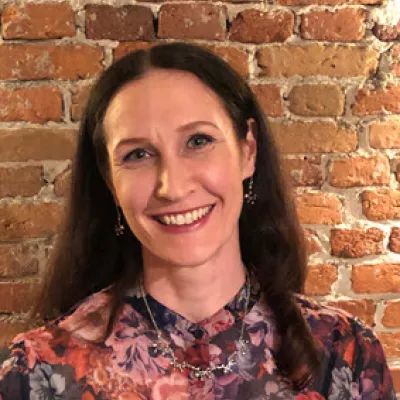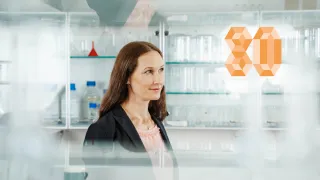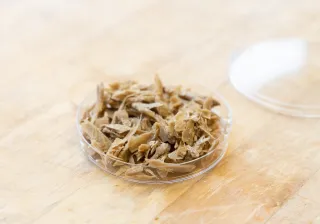Eggs without chickens, milk without cows. What on earth is going on? Both are good examples of cellular agriculture solutions that provide new methods for food production. “We want to be more sustainable in the production of food or food ingredients, such as egg white protein,” says Emilia Nordlund from VTT.
“It is easy for people to associate cellular agriculture with the meal-in-a-pill food seen in sci-fi movies, but that is definitely not the case, as we want to make real food but with different methods,” Nordlund emphasises.
Research Manager Emilia Nordlund has been working at VTT for 17 years, where one interesting project after another has kept her in the hook. The “eggs without chickens” project was born in a wild brainstorming session, where the idea of producing egg protein with microbes emerged.
“We received funding from VTT to test the idea. It is amazing to have the opportunity to try out these slightly crazier ideas here,” Nordlund recalls.
What do microbes, beer, eggs and chickens have in common?
If microbes can produce the same food raw materials as animals, how does it work in practice?
Brewing beer is a great example of the way microbes operate, as the yeast eats malt sugars and produces alcohol and carbon dioxide. The utilisation of microbes in food production is based on the same idea. When we grow microbes, we can feed them a wide range of food sources, such as forestry by-products or even carbon dioxide. Microbes utilize food more efficiently than chickens, and chickens also require significantly more living space to strut around compared to microbes growing in a tank. It has been estimated that the CO2 emissions in the production of egg white would decrease by as much as 72% if it was produced with microbes. However, the aim is not to replace the whole egg or to take work away from chicken farmers, but to introduce alternatives to the production of ingredients.
Eggs without chickens are directed at the food industry, where there is an enormous demand for egg white protein. It is unparalleled in functionality: it can be foamed or transformed into a gel, and it also contains nutritionally essential amino acids. In the baking and confectionery industry, for example, various exquisite structures of products are created by foaming and solidifying egg white protein.

Egg white foam.
Getting hands-on with foaming
After the idea was first thrown around, the work on the project began right away with a hands-on approach. The first thing was to figure out in a laboratory setting how the idea can be implemented. The second important step was to test whether the protein can actually foam. Once the functionality had been proven, both the microbe and the production process were developed to be more efficient.
Receiving the EARTO award and having the first protein foams in test tubes were one of the highlights of the project. Like many research projects, this one has also faced resource challenges.
“We were ahead of our time with the idea, which is why it was difficult to find project funding. Fortunately, VTT provided support to develop the technology gradually. Now we are delighted that funders have also clearly recognized the opportunities cellular agriculture has to offer,” Nordlund explains.
The new egg white protein production method is gaining ground, and development work is now being taken forward by VTT's spin-off company Onego Bio with its EUR 10 million seed funding. The company's goal is to start its own production plant in Finland in the next few years. As its first market, it has planned the United States, where regulations allow the fastest market entry.
The “eggs without chickens” technology is on the verge of important developments and contributes to paving the way for other similar cellular agriculture innovations. Nordlund points out that proteins are just one part of cellular agriculture – fats and carbohydrates are also needed, among other things. Cellular agriculture is in turn only a part of the food system. Therefore, the research is currently trying to find a wide range of different solutions for building a sustainable food system.
I want to maintain an inspiring atmosphere at VTT that provides a platform also for the crazier ideas.
Not all ideas and endeavours always take off, but it is in the nature of research to always try. Without trying, innovations would not develop, and sometimes mistakes create innovation. According to Nordlund, there are currently two patent applications under way that were born from blunders – the experiments failed to the extent that something completely new was discovered.
What does Nordlund think about the future that many think is coloured by crisis?
“I clearly see light at the end of the tunnel, and the tunnel is not even that long. Technologies for solving major problems, such as climate issues, are likely to already exist, but they must be taken to a global scale. I am a fan of technology, because it can save the planet. VTT holds all the right keys – you just need to know how to use them,” Nordlund says with a smile.
Scientific references
Production of bovine beta-lactoglobulin and hen egg ovalbumin by Trichoderma reesei using precision fermentation technology and testing of their techno-functional properties - ScienceDirect
Comparison of carbon footprint and water scarcity footprint of milk protein produced by cellular agriculture and the dairy industry | SpringerLink




